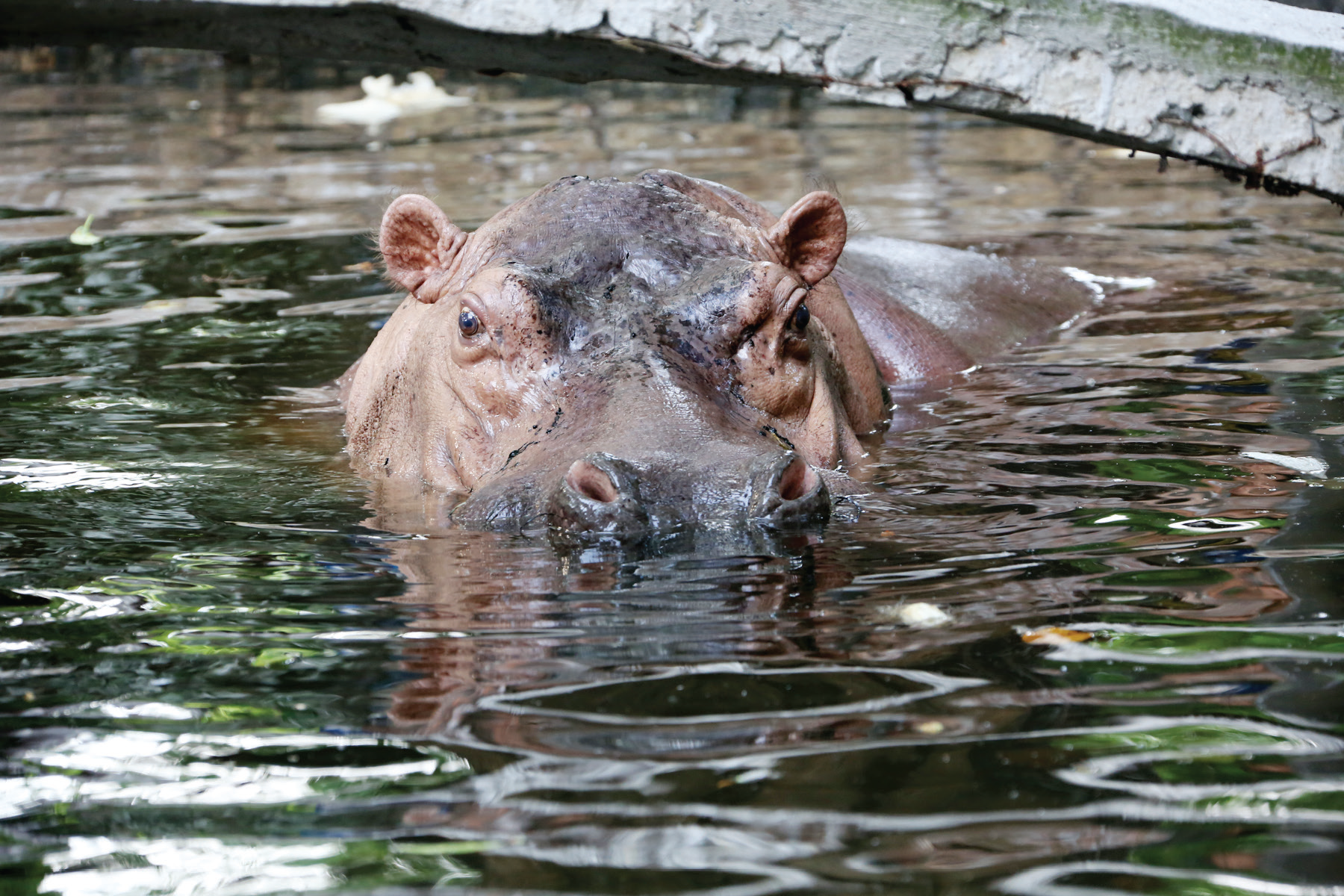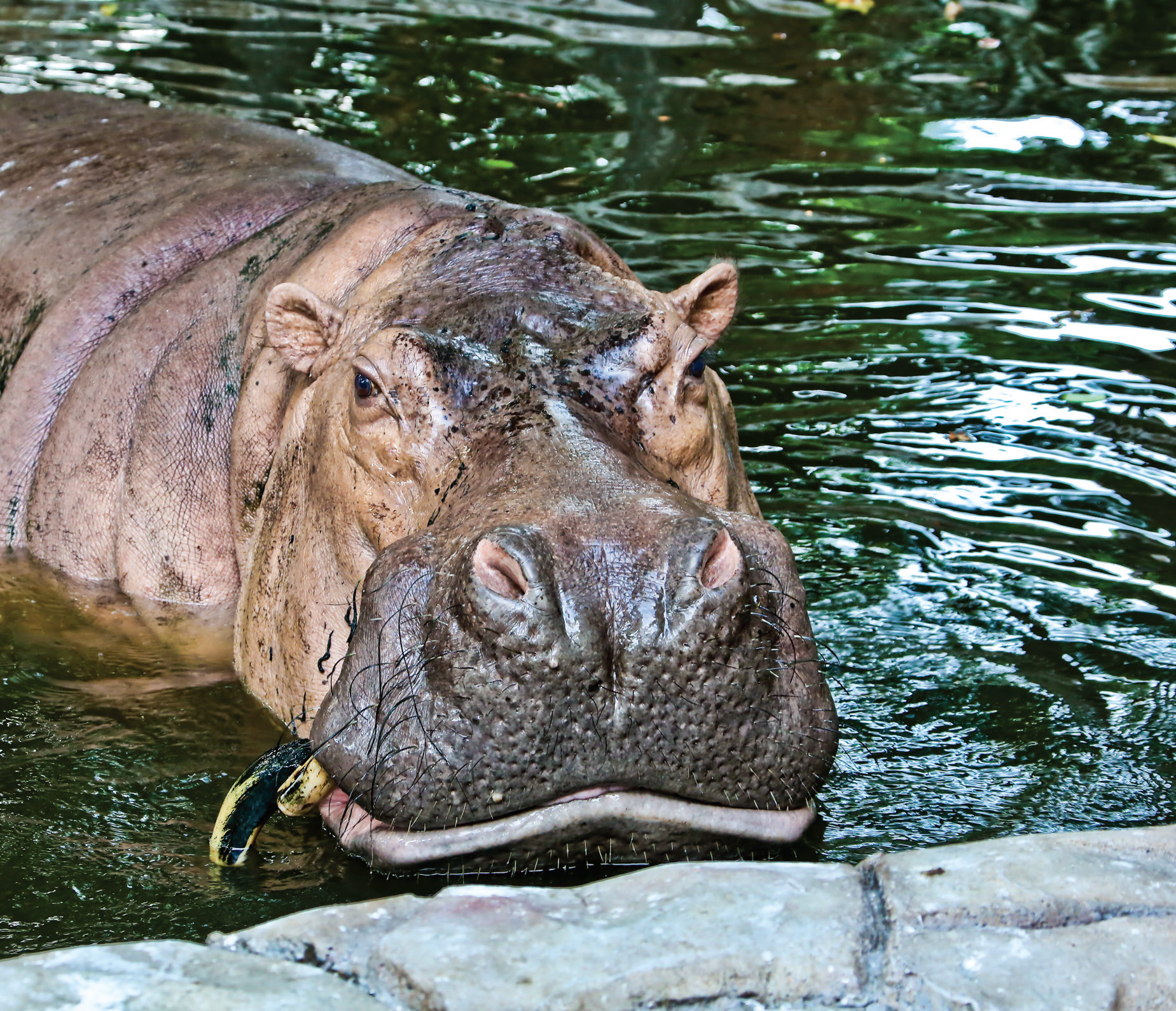Who says the Manila Zoo isn’t worth going to? Animal Scene has been quietly going there for some time now to keep an eye on the various improvements being made there, and we’ve learned from its keepers and volunteers that health monitoring and regular nutritious feeding in controlled habitats can help extend the lifespans of animals in the zoo, as compared to those in the wild, who are exposed to the dangers of poachers, diseases, lack of food, habitat loss, and nature’s harsh conditions.
We’ve got a soft spot for the aging hippo named Bertha. If you’ll recall, managing editor Jeffrey Lim fed her personally a few years back, and discovered:
- A hippo’s mouth can open as wide as 180 degrees
- While hippos are often thought to be carnivores, they are actually herbivores.
- Bertha loves grass, corn, and cabbage
- Despite her intimidating teeth, she is quite friendly and harmless.
- As a ‘senior citizen’ animal, her skin is mostly pinkish as compared to the charcoal gray of the skin of younger hippos.• Hippos, say Bertha’s keepers, are the only animals that can produce their own sunblock? Which is a good thing as they are prone to skin cancer.
Jerry Young, vice president of Animal Welfare and Operations at the Manila Zoo, answered our questions about this senior animal and hopes that people will come and visit her at the zoo soon.
Q: Can you tell us when Bertha came to the country and how she was acquired by the Manila Zoo?
A: Since the Manila Zoo was designed by Cary Baldwin, director of the [Fleishacker/Fleishhacker] Zoo in Los Angeles, and given the strong diplomatic ties of the Philippines and the United States, it is safe to assume that Bertha came from a zoo somewhere in the United States. I say this because according to the zoo staff, all records of the early years were lost.
Bertha was around to greet the first guests of Manila Zoo when they opened to the public [on] July 25, 1959. We are not sure of her age then but she can’t [have been] younger than 3 when she [arrived]. If that is the case, then she’s 61 this year (2017).
Q: Were there ever any other hippos in the zoo aside from Bertha? Has she had babies?
A: Yes, his name [was] Bert. He died in 2008. Since [arriving at the Manila Zoo], Bertha got pregnant 7 times. 6 of [her offspring] were stillborn; the last survived for a week under the care of the zoo vets.
Q: What is a typical day like for Bertha?
A: Bertha, like most hippos, [spends her] whole day under water to protect [her] skin from sunburn. She is fed [twice] everyday; the first [feeding is] at 9 AM and the second, [at] the 3 in the afternoon. Depending on her mood (or maybe the heat of the sun), Bertha often emerges for her morning feeding at 9-10 AM. She will not eat everything in one sitting and will come back to finish her food at 1 PM. [The same goes for] the afternoon feeding; she usually eats half of her food [then] comes out to finish every scrap of food at night. During the weekend, when the volunteers are present, she [feeds] more often as she looks forward to the treats the volunteers [bring] her.
She has two ponds at her disposal. Each pond can contain approximately 20,000 gallons of water. While one pond is being drained and [cleaned], she stays in the other. Each pond is drained and [cleaned] at least two times a week. Sadly, she wasn’t trained for grooming or dental care.
Q: What does she eat?
A: Bertha gets hay, potatoes, sweet potatoes (yam), and the leaves (talbos) [as part of] her staple diet. But the volunteers discovered that she loves corn (both sweet and Japanese corn) and cabbages. We also feed her carrots and squash on [occasion].
Q: Can you describe Bertha’s personality, and maybe share a few anecdotes about her antics over her years at the zoo?
A: Bertha is not only Manila Zoo’s oldest living inhabitant, but also currently the oldest living hippo in the world (both in the wild and under human care). She was known to be more assertive than her mate Bert. The foreman told us that Bertha would deliberately block the path of Bert, preventing him from entering their night enclosure for no reason at all.
But the volunteers find Bertha to be shy and gentle. For her age, she still displays good hearing and eyesight. She [responds] when I call her name and understands that my presence [means] sweet corn and cabbages. She [turns] to me and [opens] her mouth, expecting some [treat] to be thrown in. She’d even leave her food or emerge from of her water and come towards us when we visit her in her enclosure. One thing about Bertha though is, you should only approach her from the front, not from the side or back; it makes her nervous.
Q: Are there any special considerations or arrangements necessary for Bertha’s continued good he alth?
A: The Manila Zoo has a great team of veterinarians and dieticians who make sure she is healthy and cared for. As volunteers, we take care not to spook Bertha. No loud noises or sudden movements, as we noticed she frightens easily.
Q: How important is Bertha to the zoo? Aside from being a popular attraction, what does she help teach visitors to the zoo?
A: Bertha is not only one of the most loved and familiar figures inside the zoo, she is an ambassador for her species and a living testament to the love and care the animals at the Manila Zoo receive every day from their keepers and veterinary team. Visitors who see Bertha are delighted and entertained by seeing this amazing gentle giant, seeing her enjoy her meals [and how she bonds] with her friends, the zoo volunteers.
During the time the zoo volunteers are working with Bertha, guests are educated about the plight of hippos in the wild and what they can do to help these animals in their habitat. Bertha is the perfect example of the role a zoo plays in educating the public, protecting animals from poaching and providing amazing and loving care. We are so proud that the world’s oldest hippo Bertha calls the Manila Zoo home. (Additional text and editing by CFB.)
This appeared in Animal Scene magazine’s July 2017 issue.








